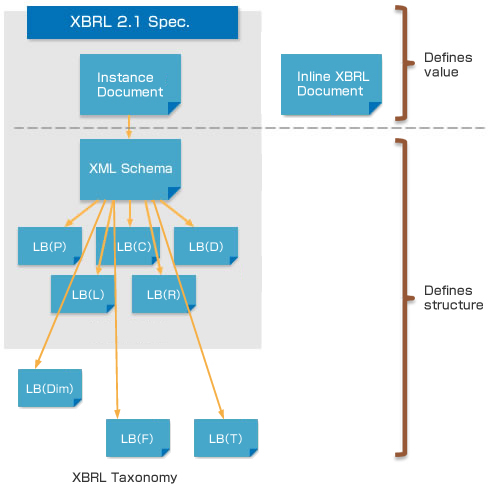Information of event
Technology of XBRL
| |Technology of XBRL -1|2| | |
XBRL specifies the standard specifications using XML which is suitable for the creation, distribution, analysis and exchange of financial information for business reports. As the basic specifications, XBRL 2.1 Specification (hereinafter called XBRL 2.1) was published by a global organization, XBRL International, on February 20, 2013.In XBRL 2.1, XML related technologies standardized in World Wide Web Consortium (W3C) such as XML Schema and XLink are positively adopted.
Business reporting information is described with XBRL in following two kinds of document.
| (1) XBRL Instances |
|---|
| This is a document in which business reporting information is described. It contains context information defining a quarter and a fiscal year, currency unit such as yen and dollar, unit representing the number of stocks as well as values and text of the reporting. In addition to the above features of instance documents, Inline XBRL 1.0 was recommended on April 20, 2010 (updated to Inline XBRL 1.1 on November 18, 2013), as one of the solutions to also achieve formatting information along with them. This specification provides a mechanism for embedding tags such as values, texts, contexts, and units that are the components of instance documents into the (X)HTML commonly used as document description language on Web. Also, it enables embedded tag information to be extracted easily and comes with a benefit of easy restoration of instance documents. Thus, many countries including Japan have started to apply it to their systems. The definition of a title name of account (label) and the order of listing for each item and the computational relations are described in XBRL taxonomies stated below. |
| (2) XBRL Taxonomy | ||||||||||||||||||||||
|---|---|---|---|---|---|---|---|---|---|---|---|---|---|---|---|---|---|---|---|---|---|---|
| XBRL Taxonomy defines the contents, structure, usage of instance documents using taxonomy schemas (XML schemas) and linkbases. Especially in XBRL 2.1, adopting linkbase using XLink technology enables business reporting information available for various applications. An XBRL Taxonomy is described in two kinds of document. |
||||||||||||||||||||||
| Taxonomy schema (XML Schema) Taxonomy schemas define vocabularies (ex. element names, attributes, etc.) of instance documents in XML schema format. Specific items such as title names of account and notes are defined here. Reference to the linkbase described below is defined in this taxonomy schema. |
||||||||||||||||||||||
| Linkbase The relationship between the items and additional information of each item is defined using XLink extended link function for items defined in taxonomy schema. In detail, it defines the view order of each item, how to calculate, labels of the value viewed as titles of account. These definitions can be created in separate file from the file of taxonomy schema. Links of the XBRL taxonomy defined by XBRL is following link definitions. (The links can be categorized in two major link definitions: a basic link definition built in XBRL 2.1 Spec., an advanced link definition defined additionally.) In XBRL, these link definitions are separated in each file as an individual linkbase.
|
||||||||||||||||||||||
Figure 1 illustrates XBRL 2.0 Spec. stated above.
Figure 1 The structure of XBRL 2.1 Spec.

(Legend)
| Target | Contents | XBRL2.1 Standard |
|---|---|---|
| Instance document | Defines value of items | Standard |
| Inline XBRL document | Defines value of an item embedding in (X)HTML file | Extend |
| XML Schema | Defines a tag name (vocabulary) of an item | Standard |
| LB(P) | Defines the view order of items (Presentation Linkbase) | Standard |
| LB(C) | Defines an addition formula of item values (Calculation Linkbase) | Standard |
| LB(D) | Defines the relationship between items (Definition Linkbase) | Standard |
| LB(L) | Defines a view label of an item (Label Linkbase) | Standard |
| LB(R) | Defines reference documents of items | Standard |
| LB(Dim) | Defines multidimensional data structure between items (expressed in Dimensions, Definition Linkbase) |
Extend |
| LB(F) | Defines complex calculation relations and business rules between items (expressed with Formula, Generic Linkbase) |
Extend |
| LB(T) | Defines structure of table format of items (expressed in Table Linkbase, Generic Linkbase) |
Extend |
XBRL 2.1 is designed for flexible introduction of these new features and is accessible for various business needs.
![]()
| |Technology of XBRL -1|2| |